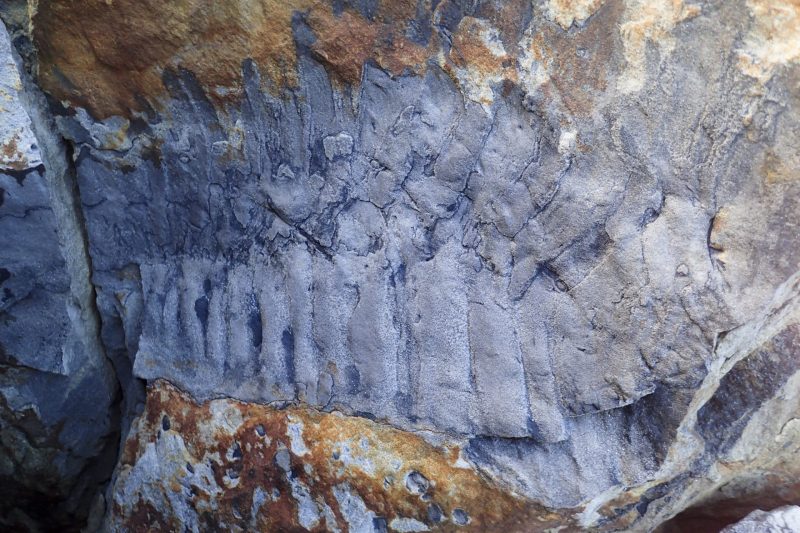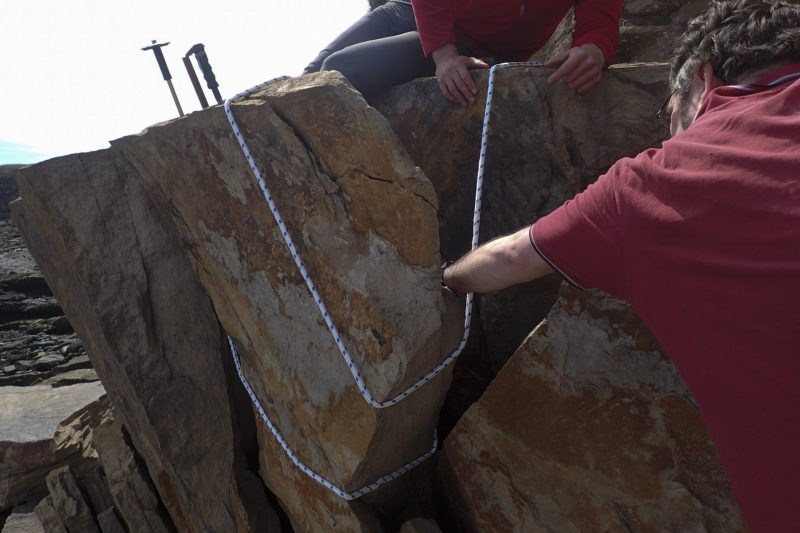
On December 21, 2021, scientists announced they’d discovered a giant millipede fossil. The creature’s total size would have been as big as a car, some 9 feet (2.7 m) long. The story of its discovery began in January 2018, when a large block of sandstone containing the fossil fell from a cliff onto the beach at Howick Bay in Northumberland, England. Lead author Neil Davies of the University of Cambridge said:
The way the boulder had fallen, it had cracked open and perfectly exposed the fossil, which one of our former Ph.D. students happened to spot when walking by.
The peer-reviewed Journal of the Geological Society published the paper on the new millipede fossil on December 21, 2021.
This beachcombing find is the largest and oldest millipede fossil to date. The fossil preserves the exoskeleton sections of an Arthropleura, the largest-known invertebrate animal of all time. The fossil is from the Carboniferous Period, about 326 million years ago, more than 100 million years before the dinosaurs. The fossilized segment is about 30 inches (75 centimeters) long. Scientists estimate the total length of the creature would have been nearly 9 feet (2.7 meters). The millipede would have weighed about 110 pounds (50 kilograms).
EarthSky 2022 lunar calendars now available! Order now. Going fast!
A rare millipede fossil
What is now a cold, wet beach in the north of England was once a tropical river channel near the equator. Researchers believe the creature shed its exoskeleton into this river. Then, the exoskeleton filled with sand, leading it to its current preserved state hundreds of millions of years later.
Scientists extracted the fossil from its beach setting in May 2018, so they could take it back to Cambridge for further study. Davies said:
It was an incredibly exciting find, but the fossil is so large it took four of us to carry it up the cliff face.
It’s only the third Arthropleura fossil known. The other two, both from Germany, are much smaller. The new specimen had a habitat in an open woodland near the coast, and the creatures only existed near the equator. Davies said:
Finding these giant millipede fossils is rare, because once they die, their bodies tend to disarticulate [come apart at the joints], so it’s likely that the fossil is a molted carapace that the animal shed as it grew. We have not yet found a fossilized head, so it’s difficult to know everything about them.

Rethinking its large origins
Before this new discovery, scientists thought the large size of the Arthropleura was related to a peak in atmospheric oxygen during the late Carboniferous and Permian periods. But the rock that preserves the new fossil dates to before this peak.
In order to grow so large, Arthropleura must have had a diet high in nutrients. Davies said:
While we can’t know for sure what they ate, there were plenty of nutritious nuts and seeds available in the leaf litter at the time, and they may even have been predators that fed off other invertebrates and even small vertebrates such as amphibians.
These millipedes existed for around 45 million years before going extinct during the Permian period. Scientists aren’t sure what caused them to go extinct. It may be due to rising temperatures that made the climate too dry for them. Another possibility is that with the rise of reptiles, they were out-competed for food and habitat.
Cambridge’s Sedgwick Museum will exhibit the fossil in early 2022.

Bottom line: Scientists recently announced the discovery of a large millipede fossil that shows the creatures were once as big as cars.
Via the University of Cambridge
Read more: What is the world’s leggiest creature?
The post Millipede fossil shows they were once as big as cars first appeared on EarthSky.
from EarthSky https://ift.tt/3fiFQ1e

On December 21, 2021, scientists announced they’d discovered a giant millipede fossil. The creature’s total size would have been as big as a car, some 9 feet (2.7 m) long. The story of its discovery began in January 2018, when a large block of sandstone containing the fossil fell from a cliff onto the beach at Howick Bay in Northumberland, England. Lead author Neil Davies of the University of Cambridge said:
The way the boulder had fallen, it had cracked open and perfectly exposed the fossil, which one of our former Ph.D. students happened to spot when walking by.
The peer-reviewed Journal of the Geological Society published the paper on the new millipede fossil on December 21, 2021.
This beachcombing find is the largest and oldest millipede fossil to date. The fossil preserves the exoskeleton sections of an Arthropleura, the largest-known invertebrate animal of all time. The fossil is from the Carboniferous Period, about 326 million years ago, more than 100 million years before the dinosaurs. The fossilized segment is about 30 inches (75 centimeters) long. Scientists estimate the total length of the creature would have been nearly 9 feet (2.7 meters). The millipede would have weighed about 110 pounds (50 kilograms).
EarthSky 2022 lunar calendars now available! Order now. Going fast!
A rare millipede fossil
What is now a cold, wet beach in the north of England was once a tropical river channel near the equator. Researchers believe the creature shed its exoskeleton into this river. Then, the exoskeleton filled with sand, leading it to its current preserved state hundreds of millions of years later.
Scientists extracted the fossil from its beach setting in May 2018, so they could take it back to Cambridge for further study. Davies said:
It was an incredibly exciting find, but the fossil is so large it took four of us to carry it up the cliff face.
It’s only the third Arthropleura fossil known. The other two, both from Germany, are much smaller. The new specimen had a habitat in an open woodland near the coast, and the creatures only existed near the equator. Davies said:
Finding these giant millipede fossils is rare, because once they die, their bodies tend to disarticulate [come apart at the joints], so it’s likely that the fossil is a molted carapace that the animal shed as it grew. We have not yet found a fossilized head, so it’s difficult to know everything about them.

Rethinking its large origins
Before this new discovery, scientists thought the large size of the Arthropleura was related to a peak in atmospheric oxygen during the late Carboniferous and Permian periods. But the rock that preserves the new fossil dates to before this peak.
In order to grow so large, Arthropleura must have had a diet high in nutrients. Davies said:
While we can’t know for sure what they ate, there were plenty of nutritious nuts and seeds available in the leaf litter at the time, and they may even have been predators that fed off other invertebrates and even small vertebrates such as amphibians.
These millipedes existed for around 45 million years before going extinct during the Permian period. Scientists aren’t sure what caused them to go extinct. It may be due to rising temperatures that made the climate too dry for them. Another possibility is that with the rise of reptiles, they were out-competed for food and habitat.
Cambridge’s Sedgwick Museum will exhibit the fossil in early 2022.

Bottom line: Scientists recently announced the discovery of a large millipede fossil that shows the creatures were once as big as cars.
Via the University of Cambridge
Read more: What is the world’s leggiest creature?
The post Millipede fossil shows they were once as big as cars first appeared on EarthSky.
from EarthSky https://ift.tt/3fiFQ1e

Aucun commentaire:
Enregistrer un commentaire